|
|
|
|
News The Project Technology RoboSpatium Contribute Subject index Download Responses Games Gadgets Contact <<< Plastic powder (1) Direct granules extruder V1 >>> Energy consumption while grinding PLAThe video about turning industrial plastic pellets into powderBuild instructionSame as the grinder in the previous chapter, the one that can be seen is still a "proof of concept" prototype with a rather inadequate material throughput. Therefore, I only offer rough assembly instructions without a parts list. A better version will follow.For those who like to experiment, the 3D files are at least available as a download package. The parts should be printed from PET as PLA cannot withstand the temperatures. 
The grinder in the previous chapter was inside a peanut can. In order to be able to experiment with slightly larger rotors, I used a 3D printed "can" with a base plate made of 1mm steel and a lid made of 6mm acrylic glass in the second "Proof of Concept" prototype. 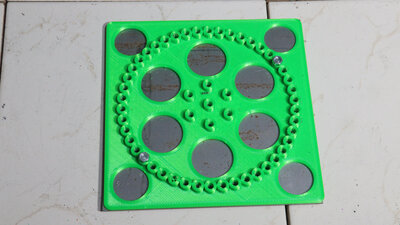
To drill the necessary holes, I made a template with a 3D printer. 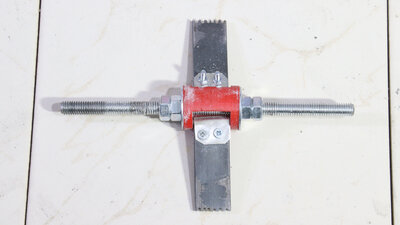
I tested various rotors with this arrangement; the variant seen here works like a hammer mill. Hammer mills have a rotor with rotatably attached tools. If they hit a particle that is trapped on the stator, the kinetic energy of this hammer is used to shred material. The system with hammers made of flat iron works in continuous operation, but more as a grinder than as a hammer, as the energy of the small flat iron is too low to hammer pellets. 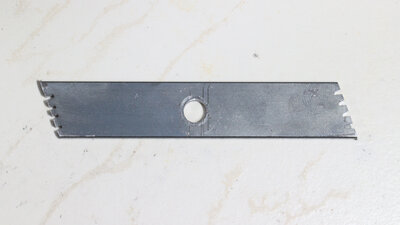
The most simple rotor was composed of a horizontally arranged flat iron with beveled and teethed ends. The stator screws are not arranged as a spiral like in the first video and the gap between the blade and the stator is large enough for a pellet to fit easily between them. This means that the rotor does not jam, but material is still removed - not only between the blade and the particle, but also between two or more particles under high shear forces. Hammer test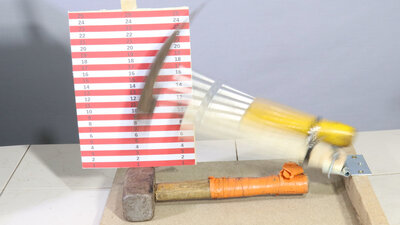
Energy is required to shred materials - the smaller the grain size of the end product, the more energy must be used. There are only a few numerical values to be found about how much specific energy is needed for plastics - anyone who knows reliable values is welcome to announce them, preferably with a reference to the source. I use simple experiments to at least be able to estimate the energy to be used. Experimental setup number one converts potential energy into kinetic energy and then uses it to smash the materials: A hammer with a hinge attached to the handle falls from a predetermined height onto the material sample. 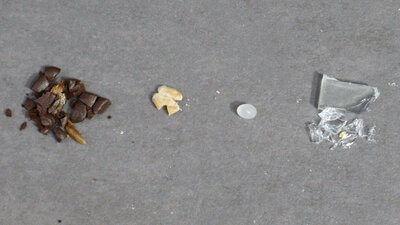
Material sample number 1 is a grain of wheat with the dimensions of approximately 6x4x3mm: A drop height of just 2cm is enough to shatter the grain. Object number 2 is a coffee bean with the dimensions 10x7x5mm. Here too, a fall height of less than 2cm is sufficient to smash the bean. Even dropping the hammer several times from a height of just 1cm smashes the coffee bean effortlessly. The following is a PLA pellet with a diameter of around 4-5mm: A drop of 2cm leaves no visible marks on the pellet. Even dropping the hammer several times from a height of 3cm does not cause the material to splinter. The last material is a piece of glass with dimensions of around 10x10x2mm: Less than 2cm is enough to shatter the material. If the hammer is dropped several times from this height, smaller and smaller splinters are formed. I worked with glass powder a few years ago and the hammer or ball mills mentioned before work very well with this material. 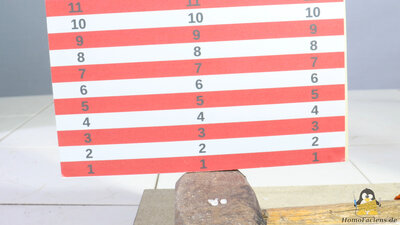
The "toughest nut" in the test series is obviously the plastic pellet at room temperature. PLA only becomes brittle at very low temperatures, so much more energy has to be put into the grinding process at room temperature than is the case with the other materials shown here. Coffee grinders are for coffee and flour mills are for flour and if you still believe that you can effectively grind PLA pellets with those types of mills: Try it out and report your results. The hammer has to be dropped from a height of around 10cm to smash a PLA pellet. Five to ten times the amount of energy is required to shred PLA. Energy consideration in the hammer experiment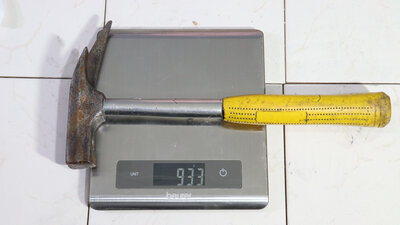
The Hammer experiment is well suited to demonstrate that significantly more energy is obviously required to shatter PLA than is the case with coffee beans, wheat or glass. But what energy is in the hammer at a given height? In order not to strain physics and mathematics too much, I'll make a few simplifications. The total weight of the hammer is 933g. So let's assume that 500g of this is located on the head of the hammer and that it would simply free fall from the given height onto the material to be examined. With these simplifications we get for the potential energy: Epot = m * g * h Epot - Potential energy m - Mass of the hammer (=500g) h - Fall height To smash a PLA pellet, the hammer had to be dropped from a height of 10cm (=0.1m) and produced 5 fragments. This created an energy of: Epot = 0.5kg * 9.81m/s2 * 0.1m = 0.4905J which is used to shatter a pellet with a diameter of around 5mm into, let's say, equally sized pieces, each 2mm in diameter. With a single pellet of 5mm diameter, a volume of: V = 4/3 * 3.14 * 2.53 = 65mm3 was shredded. With the density of PLA we get a total mass of: m = 0.065cm3 * 1.3g/cm3 = 0.0845g "plasics powder" with a grain size of 2mm. How much plastic powder like this do we get in one hour using 200W? An energy of 0.5J was required to smash one pellet and 200W means that 400 pellets can be smashed in one second and around 1.5 million pellets in one hour. With the mass of 0.0845g per pellet we get: m = 15 000 000 * 0.0845g = 127kg To shred 1kg of pellets into 2mm large grains it would only take about half a minute. Sounds fantastic, but it's a very idealized view. Losses occur when electrical energy is converted into mechanical energy and when the pellet is hammered, fragments of the same size were saurely not created. Furthermore, it would be difficult to drop the hammer on one pellet 15 million times in an hour. Cutting plasticsA different mechanism is required to process the pellets. In grinders, the pellets are thrown around and randomly smashed or ground by a rotating tool. Therefore, I carried out further experiments cutting up plastic in order to get a little closer to the energy consumption of a good grinder.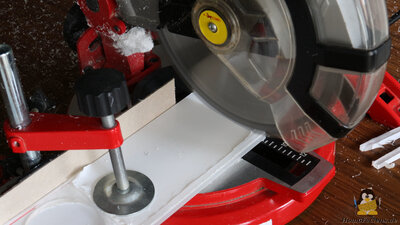
Version number 1 is a circular saw: This is used to cut 6mm thick polymethyl methacrylate, PMMA for short, or acrylic glass, but 2 panels at once, which results in a material thickness of 12mm and is done in just 3 to 4 seconds. Unfortunately, I don't have any PLA sheets in my basement The cutting length is 80mm and the cutting width is about 2mm. The electrical power consumed during cutting is between 1000 and 1300W. 
The calculations result in a volume of 1920mm³ and an energy requirement between 0.8 and 1.4Wh for the cut. With the density of 1.18g/cm³ for acrylic glass, around 2.3g of plastic powder have been created. The energy consumption per kilogram is between 347 and around 608Wh and it would take around half an hour for 1kg of plastic to be machined. The end product we get is quite coarse chips that seem unsuitable for the extruder. 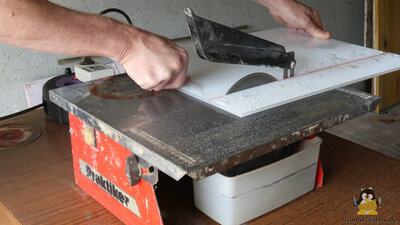
The next tool is an electric tile cutter with a diamond-coated cutting disc: This is used to cut a single sheet of 6mm acrylic glass. The cut is made over a length of 500mm. Water cooling prevents the plastic from melting. The cut takes 85 seconds. An electrical input power of around 270W is drawn. The cutting width is approximately 2.5mm. 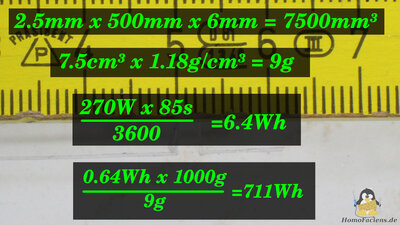
The calculations give a volume of 7500mm³, which corresponds to not quite 9g of plastic powder and an energy requirement of 6.4Wh for the cut. Using the rule of three we get an energy consumption of 711Wh/kg and with the tile cutter it would take more than two and a half hours to grind 1kg of plastic powder. The end product is at least a very fine powder. <<< Plastic powder (1) Direct granules extruder V1 >>> News The Project Technology RoboSpatium Contribute Subject index Archives Download Responses Games Links Gadgets Contact Imprint |
|
|